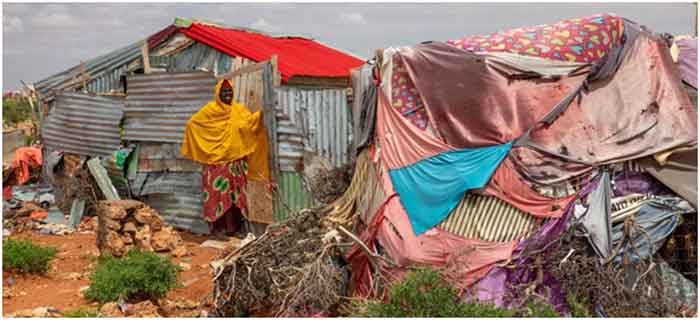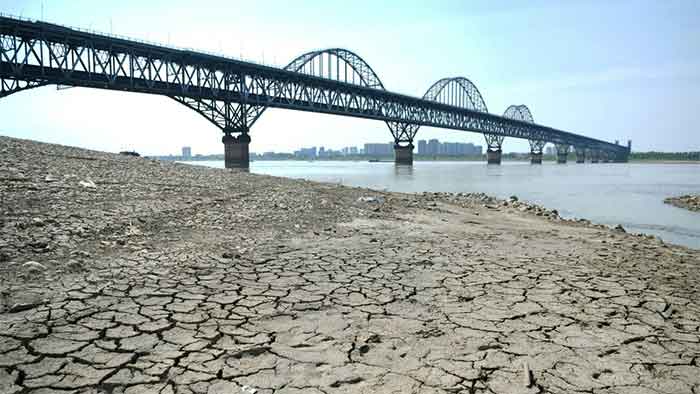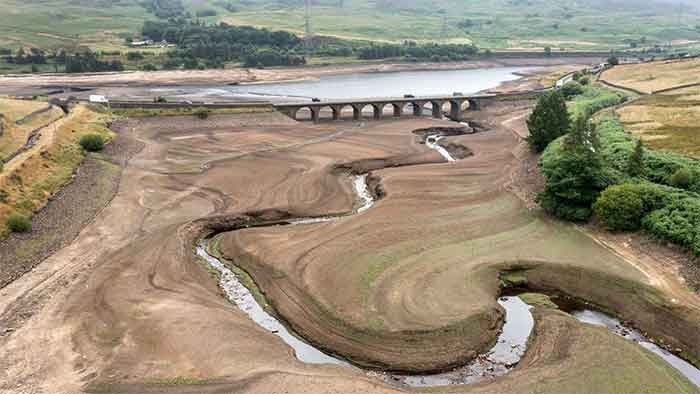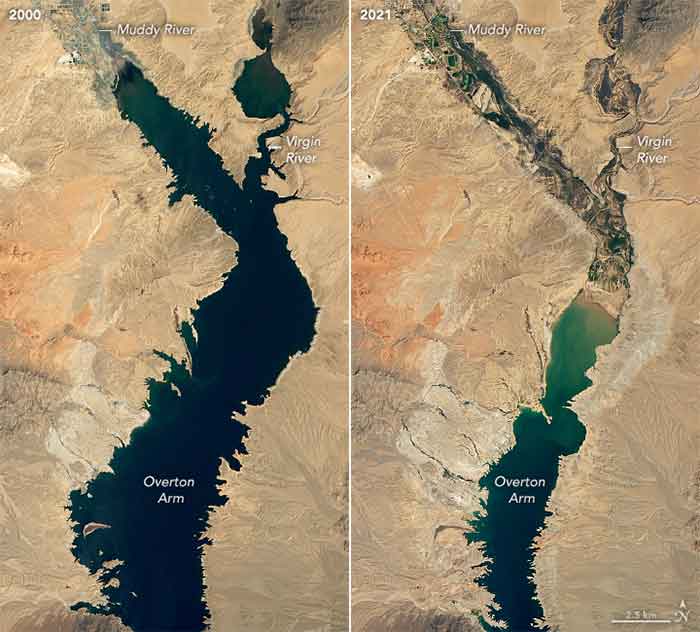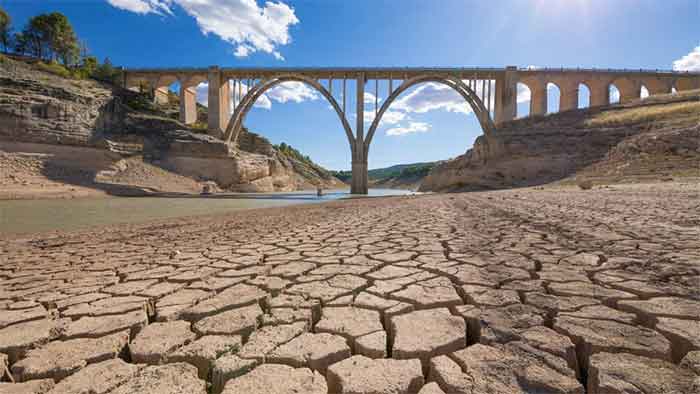
Europe is facing its worst drought in 500 years. More than 60% of the EU and U.K.’s combined lands are now under drought warnings or alerts.
Media including Reuters’ reports said:
The source of the River Thames has dried up further downstream than ever before, as England looks set to enter a drought that some experts say the country is unprepared for.
Britain’s Met Office said this July was the driest for England since 1935 with average rainfall, at 23.1 millimeters (0.9 inches), just 35% of the average for the month. Some parts of the country saw the driest July ever.
The River Thames stretches 215 miles (356 kilometers) across southern England, from Gloucestershire in the west through the heart of London, before entering the sea at Essex to the east.
The natural spring that supplies the river, known as the source, dries up most summers. But this year the dry riverbed reaches significantly further downstream than in previous years, according to observations by conservation experts.
“The Thames would normally be at its source – and there is a nice pub next to it – would be about 15 kilometers back upstream,” Alisdair Naull, an engagement officer at the Rivers Trust, told Reuters while standing in a small section of the Thames in Cricklade, about 80 km west of London.
“It is very, very shallow here … but you do not have to go much further up this little bit of the Thames to find yourself stood on dry ground. And really, that is ground that should still be wet and should always be wet.”
Naull said the shallow, warmer water contained less oxygen, which fish and other wildlife needed to thrive.
Extreme Heat
Unprecedented heat and a lack of rainfall have pushed two water companies in the country’s south to announce temporary bans on the use of hosepipes and sprinkler systems.
Thames Water, which supplies 15 million customers across London and south east England, said it was planning to introduce the similar curbs.
A four-day “extreme heat” warning came into force in parts of England and Wales on Thursday. The Met Office issued its first such warning ever last month, when temperatures breached 40C (104F) for the first time.
Climate expert and hydrologist at the University of Reading Hannah Cloke said low rainfall has left river levels and aquifers low, while water has been taken out of the waterways to irrigate crops, top up drinking water and for use in industry.
“If we do not get rain in August, in fact, if we have a dry winter, then we could be in severe trouble come spring and next summer when we really don’t have any water stores left whatsoever,” Cloke said.
She said hosepipe restrictions on individuals were useful to help change attitudes to water usage, but investment in infrastructure and policy on preventing further climate change were even more important.
Britain’s Dry Summer Set To Trigger Drought Declarations
A Reuters report said:
Parts of England are likely to declare a drought on Friday, local media reported ahead of a meeting between the government, its environment agency and water companies to discuss a long period of dry weather.
Parts of England are in the middle of their second heatwave this summer with temperatures forecast to top 30 Celsius (86 Fahrenheit) for the next few days, having reached their highest ever of more than 40C last month.
Much of Europe has been baking in high temperatures that have triggered huge wildfires, with unprecedented droughts causing shortages, threatening crops and disrupting river shipping routes.
July Was The Driest On Record
Other media reports including by CBS News said:
This July was the driest on record for some English regions and the driest for England overall since 1935, with just 35% of average rainfall.
That, coupled with continued dry forecasts, is expected to push some areas of the country to formally declare a drought after a meeting of the ‘National Drought Group’ which is due to begin on Friday morning.
Sky News said these could apply to several different reasons, citing an unnamed source in the Department for Environment, Food and Rural Affairs. The government said no decisions had yet been taken.
The British government’s environmental agency has warned that if the dry conditions continue, “many parts of England will move into drought.”
Yields Decline
The reports said:
The combination of low rainfall and successive heat waves has hit farmers hard. Some are already seeing their crop yields decline. Vegetables like broccoli and brussels sprouts should be planted now to harvest in the winter, but with much of their land parched, some farmers are delaying planting the new crop.
Others are going ahead, unsure how much might survive.
Livestock Farmers Affected
The CBS News reports said:
The dry conditions are also affecting livestock farmers. Fields where cattle graze have dried the grass that should be feeding on now. Just like in the U.S., many British and European farmers are already using their winter feed, which could cause problems later in the year.
More than 60% of the EU and U.K.’s combined lands are now under drought warnings or alerts, according to the European Drought Observatory.
One senior scientist with the European Commission warned that Europe is on course to suffer through its worst drought in 500 years.
Spain Portugal France
Wildfires are charring thousands of acres of tinder-dry brush and destroying homes in Spain, Portugal and France.
French officials have already declared it the country’s “most severe” drought on record. Authorities there say dozens of municipalities have seen their drinking water supplies run dry, leaving them to rely on water brought in by tanker trucks.
Rhine River
In Germany, water levels of the Rhine River have dropped so far that it’s making it harder for ships to transport goods, including coal and gasoline, which the country sorely needs amid soaring global energy prices.
Some ships are being forced to carry only 25% of their usual cargo capacity to avoid running aground.
Scientists have said heat waves are increasing in both frequency and intensity faster in Europe than almost anywhere else on Earth, and they say human-induced climate change is playing a critical role in those changing weather patterns.
Agriculture Hit Hard
Other media reports including by Yahoo News said:
With Europe suffering through an extreme drought worsened by climate change, farmers across the continent are sounding warnings about crop losses.
“Our vines are suffering,” said vintner Xavier Collart Dutilleul, who, with his wife Pascale, runs Château Mazeris Bellevue near Saint-Emilion in southwestern France. Lacking rain, the organic vineyard’s parched clay-rich soil is “almost as hard as cement,” he told Yahoo News, and he predicted that his harvest, which typically yields enough for 35,000 bottles, will be down by 30% this year.
Italy Spain
The Yahoo News report said:
In Northern Italy, there was little winter snow this year and even less springtime rain, and extreme summer temperatures have evaporated what little moisture remains. Just as rivers across Europe have all but dried up, the Po river, a major source of irrigation in the river’s fertile valley, is a trickle and the normally marshy rice paddies it irrigates are brown and cracked.
“We have no water,” Fabrizio Rizzotti, a seventh-generation rice farmer, told Yahoo News. “The plants are curling up and dying in the fields.” This year, he expects his harvest of carnaroli rice, favored for risotto, to be 30% of what it was last year.
Olive Yield
In Spain, which provides nearly half the world’s olive oil, Agricultural Minister Luis Planas last week warned that “this year’s olive harvest could be notably lower than previous ones.” Spain’s Association of Young Farmers and Ranchers (ASAJA) predicts that olive yields will drop by a third. “We are in a very bad situation, with a fundamental water deficit in our agriculture,” José-Luis Miguel, technical coordinator for Spain’s largest agricultural group COAG, told Yahoo News. He also said that restrictions on irrigation and scant rainfall have meant that “many crops have not been able to be planted or have had to be replaced by others with less water needs.” Grain production, for one, is down by 25%, he said.
“What is happening this year is very scary,” enologist Ton Mata, third-generation owner and CEO of the Recaredo vineyard in Spain’s cava region, Alt Penedès, told Yahoo News. “We have little rain and a very long, dry, hot period with three heat waves. We are seeing that the grapes are very small and weigh less.” Although the harvest is just beginning, he’s sure that the yield will be down by 20% to 40%.
This summer, Europe is breaking all kinds of records, from high temperatures to low precipitation amounts. Nearly two-thirds of the territory in the 27-country European Union is either dealing with drought or is poised to enter one. The European Drought Observatory this week said that 47% of the EU territory was in warning conditions while 17% was “under alert,” meaning that vegetation is stressed due to lack of water. The countries most affected — France, Spain and Italy, as well as Germany — are those that produce the bulk of Europe’s food, a fact that means prices for European commodities are sure to soar this fall and winter.
Climate expert Jorge Olcina, professor of regional geographic analysis at Spain’s University of Alicante, told Yahoo News that what is happening across Europe is “further evidence of the process of global warming” — and he expects it to continue. “The trend is clear. We’ve failed to reduce the level of greenhouse gases we put into the Earth’s atmosphere and the process of heating continues its unstoppable process.”
The Mediterranean
Hydrologist Jesús Carrera foresees “a severe reduction in precipitation throughout the Mediterranean.” But the main problem, he said, is not only “that there will be longer and more intense droughts, but there will be also very wet periods. So obviously, the way to manage this is to save water from the wet periods.”
It is not just blistering summer heat and water shortages that are reducing food supplies — it is the strange weather in general that has been plaguing Europe for over two years that has farmers and climatologists concerned. “These last years have been crazy,” said Spanish agricultural consultant Montse Boldú Giménez.
Fruit Crops Destroyed
Seasons when rain usually comes are instead dry; when the skies open up, they dump torrents that wash away topsoil. A late spring frost destroyed many of Spain’s fruit crops, and hailstorms, like the one a few weeks ago that wiped out a vineyard next to Château Mazeris Bellevue, are becoming more frequent. “The hailstones were as big as eggs,” said vintner Collart Dutilleul.
Blizzard
Last year, a fluke blizzard hit central Spain, blanketing olive groves in Toledo in 5 inches of snow, and two weeks of below-freezing temperatures killed a quarter of the zone’s oldest olive trees.
“We have been observing changes for many years — but now it is more obvious. You can see it everywhere,” José Antonio Peche Marín-Lázaro, managing director of premium olive oil producer Casas de Hualdo, which lost 250 acres of olive trees in that storm, told Yahoo News.
He said that locals who are 80 or 90 years old and have worked in the fields their whole lives often tell him they do not remember anything like the weather of recent years. “And when you look at the olive trees here in this area, some of which are 200 years old, that have survived for such long periods, but now, this weather is threatening their survival, that definitely means that something has changed,” he added.
Rethink Farming Practices
The changing weather patterns are forcing many Europeans to rethink centuries-old farming practices.
“Some crops will have to alter their production cycles, and irrigation systems should be improved to increase their efficiency,” said Olcina, who views climate change not only as “the most important issue we’re facing,” but also “as an opportunity to get things right.”
Indeed, some food producers already are starting to change. Casas de Hualdo has put water monitors into its olive groves and has installed a more effective subterranean irrigation system and solar panels to power it. Mata’s Recaredo vineyard is trying out different grapes that are better suited to unrelenting sun; it is also changing rootstocks to varieties “that need less water and that go deeper into the soil” to allow vines to get more water. Recaredo is also using biodynamic practices, with ground cover in its vineyard that encourages more worms to aerate the soil. At Château Mazeris Bellevue, they are also trying out different grapes that are more resistant to heat and drought.
Nancy Harmon Jenkins, author of “The New Mediterranean Diet Cookbook” and owner of an olive grove in Tuscany, isn’t all that anxious about this summer’s diminishing crops. Olives and grapes can survive droughts, she pointed out to Yahoo News, and vineyards have suffered disasters like the wave of phylloxera that wiped out many French vineyards in the 1800s. “I think there’ll be plenty of olive oil and plenty of wine for my grandchildren,” she told Yahoo News. What she is concerned about is how climate change will change their world. “They have to worry about keeping cool in the summer and rising sea levels” — along with droughts. “Those are much more critical issues to me than olive oil and wine.”
Despite this tumultuous summer, hydrologist Carrera is not sure the public or politicians are grasping the need to change. “Society only reacts when it’s hurt,” he observed. “It doesn’t hurt enough yet.”
Wildfires Spread, Fish Die Off
An AP report said:
Firefighters from across Europe struggled Thursday to contain a huge wildfire in France that has swept through a large swath of pine forest, while Germans and Poles faced a mass fish die-off in a river flowing between their countries.
Europe is suffering under a severe heat wave and drought that has produced tragic consequences for farmers and ecosystems already under threat from climate change and pollution.
The drought is causing a loss of agricultural products and other food at a time when supply shortages and Russia’s war against Ukraine have caused inflation to spike.
Wildfire In France
In France, which is enduring its worst drought on record, flames raged through pine forests overnight, illuminating the sky with an intense orange light in the Gironde region, which was already ravaged by flames last month, and in neighboring Landes. More than 68 square kilometers (26 square miles) have burned since Tuesday.
The French wildfires have already forced the evacuation of about 10,000 people and destroyed at least 16 houses.
Dead Fish Along The Oder River
Along the Oder River, which flows from Czechia north into the Baltic Sea, volunteers have been collecting dead fish that have washed ashore in Poland and Germany.
Piotr Nieznanski, the conservation policy director at WWF Poland, said it appears that a toxic chemical was released into the water by an industry and the low water levels caused by the drought has made conditions far more dangerous for the fish.
“A tragic event is happening along the Oder River, an international river, and there is no transparent information about what is going on,” he said, calling on government authorities to investigate.
People living along the river have been warned not to swim in the water or even touch it.
Poland
Poland’s state water management body said the drought and high temperatures can cause even small amounts of pollution to lead to an ecological disaster but it has not identified the source of the pollution.
Serbia
In northern Serbia, the dry bed of the Conopljankso reservoir is now littered with dead fish that were unable to survive the drought.
Po River In Italy
In Italy, which is experiencing its worst drought in seven decades, the parched Po River has already caused billions of euros in losses to farmers who normally rely on Italy’s longest river to irrigate their fields and rice paddies.
“I am young and I do not remember anything like this, but even the elderly in my village or the other villages around here have never seen anything like this, never ever,” said Antonio Cestari, a 35-year-old farmer in Ficarolo who says he expects to produce only half his usual crops of corn, wheat and soy because his river-fed wells have such low water levels.
The Po runs 652 kilometers (405 miles) from the northwestern city of Turin to Venice. It has dozens of tributary rivers but northern Italy hasn’t seen rainfall for months and this year’s snowfall was down by 70%. The drying up of the Po is also jeopardizing drinking water in Italy’s densely populated and highly industrialized districts.
Over in Portugal, the Serra da Estrela national park was also being ravaged by a wildfire. Some 1,500 firefighters, 476 vehicles and 12 aircraft were deployed to fight it but the wind-driven blaze 250 kilometers (150 miles) northeast of Lisbon was very hard to reach, with inaccessible peaks almost 2,000 meters (6,560 feet) high and deep ravines. The fire has charred 10,000 hectares (25,000 acres) of woodland.
340 Grass And Garbage Fires In London
London Fire Brigade said its control room had dealt with 340 grass, garbage and open-land fires during the first week of August, eight times the number from last year. Assistant Commissioner Jonathan Smith said “the grass in London is tinderbox dry and the smallest of sparks can start a blaze which could cause devastation.”
Switzerland
In Switzerland, a drought and high temperatures have endangered fish populations and authorities have begun moving fish out of some creeks that were running dry.
In Hausen, in the canton of Zurich, officials caught hundreds of fish, many of them brown trout, in the almost dried-up Heischerbach, Juchbach and Muehlebach creeks this week by anesthetizing them with electric shocks and then immediately placing them in a water tank enriched with oxygen, local media reported. Later, the fish were taken to creeks that still carry enough water.
Despite all the harm caused by the extreme weather, Swiss authorities see one morbid upside: they believe there’s hope of finding some people who went missing in the mountains in the last few years because their bodies are being released as glaciers melt.
In the Swiss canton of Valais, melting glaciers have recently revealed parts of a crashed airplane and, at separate locations, at least two skeletons. The bodies have not yet been identified, news website 20Minuten reported Thursday.
Trucks From France, Stay In Spain
Spanish state television showed dozens of trucks heading to France having to turn around and stay in Spain because wildfires had forced authorities to close some border crossings. TVE reported that truckers, many carrying perishable goods, were looking for ways to cross the border because the parking areas around the Irun crossing were full.
Farmers Struggle
Another Reuters report said:
European nations sent firefighting teams to help France tackle a “monster” wildfire on Thursday, while forest blazes also raged in Spain and Portugal and the head of the European Space Agency urged immediate action to combat climate change.
More than 1,000 firefighters, backed by water-bombing planes, battled for a third day a fire that has forced thousands from their homes and scorched thousands of hectares of forest in France’s southwestern Gironde region.
With a dangerous cocktail of blistering temperatures, tinder-box conditions and wind fanning the flames, emergency services were struggling to bring the fire under control.
“It’s an ogre, a monster,” said Gregory Allione from the French firefighters body FNSPF said.
Heatwaves, floods and crumbling glaciers in recent weeks have heightened concerns over climate change and the increasing frequency and intensity of extreme weather across the globe.
The head of the European Space Agency, Josef Aschbacher, said rising land temperatures and shrinking rivers as measured from space left no doubt about the toll on agriculture and other industries from climate change.
ESA’s Copernicus Sentinel-3 satellite series has measured “extreme” land surface temperatures of more than 45C (113F) in Britain, 50C in France and 60C in Spain in recent weeks.
“It’s pretty bad. We have seen extremes that have not been observed before,” Aschbacher told Reuters.
Romania
In Romania, where record temperatures and drought have drained rivers of water, Greenpeace activists protested on the parched banks of the Danube to draw attention to global warming and urge the government to lower emissions.
Climate Crisis Risks
The report said:
With successive heatwaves baking Europe this summer, searing temperatures and unprecedented droughts, renewed focus has been placed on climate change risks to farming, industry and livelihoods.
Maize Harvest
Severe drought is set to slash the European Union’s maize harvest by 15%, dropping it to a 15-year a low, just as Europeans contend with higher food prices as a result of lower-than-normal grain exports from Russia and Ukraine.
Swiss Army Helicopters
Swiss army helicopters have been drafted in to airlift water to thirsty cows, pigs and goats sweltering under a fierce sun in the country’s Alpine meadows.
Taps Run Dry In French Villages
In France, suffering its harshest drought on record, trucks are delivering water to dozens of villages where taps have run dry, nuclear power stations have received waivers to keep pumping hot discharge water into river, and farmers warn a fodder shortfall may lead to milk shortages.
Workers In Gig-Economy
However, as Europe contends with another heatwave, one group of workers has little choice but to sweat it out: gig-economy food couriers who often fall between the cracks of labor regulations.
After the mayor of Palermo on the island of Sicily in July ordered horses carrying tourists be given at least 10 litres of water per day, bicycle courier Gaetano Russo filed a suit demanding similar treatment.
“Am I worth less than a horse,” Russo was quoted as saying in a Nidil CDIL union statement.
Electrical Storms
In Spain, electrical storms triggered new wildfires and hundreds of people were evacuated from the path of one blaze in the province of Caceres.
Macron’s office said extra fire-fighting aircraft were arriving from Greece and Sweden, while Germany, Austria, Romania and Poland were all deploying firefighters to help tackle wildfires in France.
Firefighters said they had managed to save the village of Belin-Beliet, which emptied after police told residents to evacuate as the flames approached. But the blaze reached the outskirts, leaving behind charred houses and ruined tractors.
“We have been lucky. Our houses were saved. But you see the catastrophe over there. Some houses could not be saved,” said resident Gaetan, pointing to houses burnt to the ground.
The Gironde was hit by big wildfires in July.
“The area is totally disfigured. We are heartbroken, we are exhausted,” Jean-Louis Dartiailh, a local mayor, told Radio Classique. “(This fire) is the final straw.”
Climate Risks Dwarf Europe’s Energy Crisis
A Reuters report said:
The head of the European Space Agency (ESA) has warned economic damage from heatwaves and drought could dwarf Europe’s energy crisis as he called for urgent action to tackle climate change.
Director General Josef Aschbacher told Reuters successive heatwaves along with wildfires, shrinking rivers and rising land temperatures as measured from space left no doubt about the toll on agriculture and other industries from climate change.
“Today, we are very concerned about the energy crisis, and rightly so. But this crisis is very small compared to the impact of climate change, which is of a much bigger magnitude and really has to be tackled extremely fast,” he said.
He was speaking in an interview as heatwaves and floods generate concerns over extreme weather across the globe.
More than 57,200 hectares have been swallowed by wildfire in France this year, nearly six times the full-year average.
In Spain, a prolonged dry spell made July the hottest month since at least 1961.
Earth’s Skin
Soaring air temperatures are not the only problem. The Earth’s skin is getting warmer too.
Aschbacher said ESA’s Copernicus Sentinel-3 satellite series had measured “extreme” land surface temperatures of more than 45C in Britain, 50C in France and 60C in Spain in recent weeks.
Land surface temperature drives air circulation.
“It is really the whole ecosystem that is changing very, very fast and much faster than what scientists expected until some years ago,” he said.
“It is drought, fires, intensity of storms, everything coupled together, which are the visible signs of climate change.”
As changes in temperature also become more marked, winds become stronger and unleash harsher storms.
“Typhoons are much more powerful than they used to be in terms of wind speed and therefore damage,” Aschbacher said.

